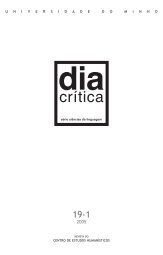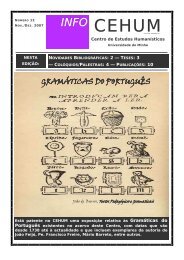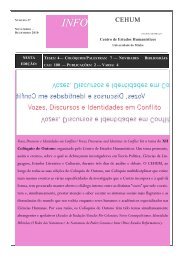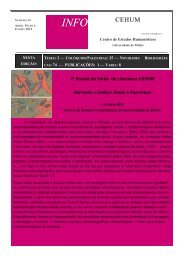Diacritica 25-2_Filosofia.indb - cehum - Universidade do Minho
Diacritica 25-2_Filosofia.indb - cehum - Universidade do Minho
Diacritica 25-2_Filosofia.indb - cehum - Universidade do Minho
You also want an ePaper? Increase the reach of your titles
YUMPU automatically turns print PDFs into web optimized ePapers that Google loves.
QUEEN CAROLINE AND THE PRINT CULTURE OF REGENCY RADICALISM<br />
171<br />
ated the pace of print production. On the other hand, the erosion of the<br />
seriousness of the discourse of authority – the basis of satiric laughter – that<br />
resulted from the acquittals of Hone and Wooler at their 1817 trials also<br />
played a part. At Hone’s fi rst trial, the grave, authoritative warning by Mr.<br />
Justice Abbott only elicited more laughter from the audience:<br />
If there is any body present of so light a disposition as to think that a matter<br />
of this kind should be made a subject of laughter, at least he shall learn that<br />
he shall not come here to interrupt those who are of a graver disposition, and<br />
in the discharge of an important duty (Hone, 1818: 5).<br />
Pamphlet satires were popular sub-literary genres during the Queen<br />
Caroline aff air. In 1820 over sixty volumes of satirical verse were published,<br />
against a total of 201 volumes of poetry, according to J. R. Jackson’s incomplete<br />
list Annals of English Verse, 1770-1835 (Dyer, 1997: 12). Th e average<br />
cheaper price of pamphlet satires in relation to satirical prints [16] and their<br />
relatively quick production lent themselves to prompt and popular political<br />
comment.<br />
Hone (1780-1842) was a pivotal fi gure in the production of satiric<br />
pamphlets on behalf of Queen Caroline in partnership with the caricaturist<br />
George Cruikshank (1792-1878). Despite his initial reluctance to join the<br />
Queenites – imprisonment and trials in 1817 had left indelible fi nancial<br />
and psychological marks – he shared in the movement on behalf of Queen<br />
Caroline, both with the pen and the press. It was his last overt and serious<br />
political commitment.<br />
Hone’s was a creative response to the Aff air. Although he also wrote<br />
or published non-satirical texts [17] supporting the Queen, by far his most<br />
relevant contribution was satirical. Like Wooler, Hone used satiric laughter<br />
as a counter-discourse of resistance to the hegemonic power summoned<br />
against the Queen, oft en intertwined with the theme of the power of the<br />
press, a most cherished theme by Hone, as by radicals in general.<br />
16 Most pamphlet satires cost one shilling, whereas the price of satirical prints varied, according<br />
to size, colouring, or detail. ‘Plain’ prints usually cost one shilling, but coloured ones cost two<br />
shillings (Baker, 2005: 18).<br />
17 Hone wrote two non-satirical pamphlets in 1820, supporting the Queen – Th e King’s Treatment<br />
of the Queen, Shortly Stated to the People of England (Hone, 1820b) and Th e Form of Prayer<br />
(Hone, 1820c). Although the latter text parodies the practice of issuing ‘a form of prayer’ to<br />
celebrate a major event in the monarchy, the tone is not satirical; he also published the Queen’s<br />
Letter to the King (Hone, 1820a); in 1821, Hone wrote two further pamphlets –To the King, from<br />
the Author of Th e King’s Treatment of the Queen (Hone, 1821a), and An Accurate Report of the<br />
Trial of Her Most Gracious Majesty Queen Caroline (Hone, 1821b).<br />
<strong>Diacritica</strong> <strong>25</strong>-2_<strong>Filosofia</strong>.<strong>indb</strong> 171 05-01-2012 09:38:28











![Programa [pdf] - cehum - Universidade do Minho](https://img.yumpu.com/17305425/1/190x135/programa-pdf-cehum-universidade-do-minho.jpg?quality=85)




